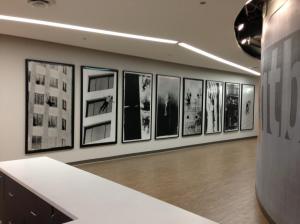
Image via Twitter, click to enlarge
Lightbank, the venerated Chicago-based venture capital firm, made a very good decision this morning: It’s removing these large-scale photos of people falling from buildings that have been hanging in its lobby for the past couple days.
Of course, the question is why anyone thought this kind of decoration would be a good idea in the first place (not surprisingly, the negative outcry was swift and captured on Twitter.)
Reached via telephone today, a Lightbank spokesperson said that the initial decision to display the photos was to represent the “risk and journey of entrepreneurship” and out of a general appreciation of the art, as the firm’s office is filled with modern artwork and photography. “But once people started reacting to it, and we saw the other implications that were being taken from it, it was an immediate decision to take it down.”
Edgy office design is fairly common in tech, as we see in our Cribs series all the time. But it’s clear that this went too far, especially in light of recent tragedies in the industry.
Some more details: The photos are from a 1980 exhibit by artist Sarah Charlesworth called ‘Stills’ that were displayed once again in 2012 in an art show commemorating the World Trade Center attacks. Art journalist Robin Cembalest explains the concept best here:
“The artist had made the pictures, huge blow-ups of newspaper images of people falling mid-air, back in 1980. She reproduced the name of the person, if the journal had published it, in the caption, but without saying whether they were jumping or falling—or whether they had lived or died.
Back then, Charlesworth saw the ‘Stills’ as a way to explore the power of photographs to elicit certain emotional reactions. ‘The people in midair became a metaphor between certain life and eventual death that we all live all the time,’ she explains.”
This kind of concept may be great in a gallery, but it was a bad move to bring it into a corporate setting, even in the more open-minded and casual tech world. It’s good to see that Lightbank recognizes that now, and isn’t digging in its heels or trying to justify the decision.